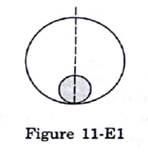A solid sphere of mass m and radius r is placed inside a hollow thin spherical shell of mass M and radius R as shown in figure (11-E1). A particle of mass m’ is placed on the line joining the two centers at a distance x from the point of contact of the sphere and the shell. Find the magnitude of the resultant gravitational on this particle due to the sphere and the shell if (a) r < x < 2r, (b) 2r < x < 2R. and (C) x > 2R.

Here, the force on the particle is due to shell and the sphere. But in cases (a) and (b), the particle is inside the spherical shell. So, the force due to shell is zero in these cases.
(a)Here, the distance of the particle from the center of solid sphere is ![]() .
.
Now a sphere of radius ![]() will impart a gravitational force on the object. The mass of the sphere is m’.
will impart a gravitational force on the object. The mass of the sphere is m’.
The force is given by ![]()
![]()
(b) Here, the particle is inside the shell but outside the sphere. the distance of the particle from the center of solid sphere is ![]() .
.
Therefore, the force is simply due to the sphere at a distance of ![]() .
.
![]()
(c) Here, the particle is outside the spherical shell. So the force experienced by the particle is due to both the sphere and the shell.
Force due to sphere is at a distance of ![]() is
is ![]()
Distance of particle from spherical shell is ![]() . Again the force due to shell is as if all the mass if concentrated at its center.
. Again the force due to shell is as if all the mass if concentrated at its center.
![]()
Therefore, the net force is
![]()